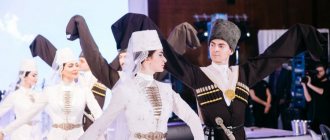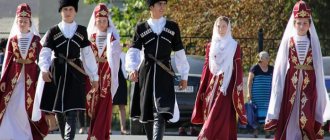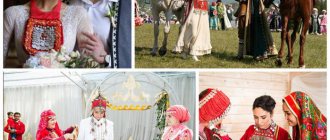The desire to have a wedding, observing the rituals and traditions of one’s people, will fill an important event in the life of a couple in love with bright color and ethnic identity.
For a Muslim young family, performing a wedding ceremony following the unwritten laws of their ancestors, touching with all their hearts the rich cultural heritage, is considered an excellent start to life together. A Tatar wedding is a wedding celebration of amazing beauty and unique national performance. By organizing a holiday in this way, a young couple announces to everyone about the strength of their marriage.
Where does a Tatar wedding begin?
Preparations for the Tatar holiday begin in advance - long before the official date of the celebration is determined. First, the mullah blesses the matchmaking and conspiracy carried out by the parents of the young people. Moreover, the bride and groom do not take part in discussing everyday issues. Matchmaking takes place in stages:
- meeting of the bride, bridesmaid,
- matchmakers' story about the groom,
- meeting of the parties.
The newlywed is represented by a matchmaker and one of the older relatives who take an active part in the first two rituals. If everything went well, parents join the meeting of the parties. Negotiations are an important part of preparing for a special event. Numerous issues related to the place of residence of young people, the income of the future family, bride price, and the participation of relatives in the purchase of household items are discussed here.
According to the customs of the Tatar people, the bride price must be paid in full before the wedding or on the wedding day. This can be not only money, but also jewelry, clothing, bed linen, dishes, and real estate. The newlywed's dowry is not discussed during the wedding ceremony.
Upon completion of all stages of preparation, the negotiators inform the young people of the wedding date. After which they begin to discuss the celebration itself. It includes the following.
- A Muslim wedding Nikah is a ceremony that is performed according to the Law of Islam in a mosque. It signifies the sacred union between a man and a woman and their rights to legal family relationships. During the ceremony, the Koran is read, the newlyweds make sacred vows, and parents bless their children.
- Legal legitimation of marriage in the registry office. On the day of the engagement, the bride and groom submit an application for marriage registration, after which the girl is considered engaged.
- The Tui Tatar wedding celebration is a multi-day celebration that takes place first with the bride and then with the groom. Modern families celebrate this event for several days in a restaurant. Tatar congratulations on the wedding sound.
If the families of the bride and groom have known each other for a long time, with mutual consent, the engagement and negotiations are carried out in one day. The event is usually organized in the bride's house, at the festive table. Relatives of the newlyweds not only agree on the wedding, but also give each other gifts.
Usually, preparing for a wedding takes a long time - more than a month. The groom gives the bride price in parts and buys gifts for the bride and her relatives. The newlywed's family prepares a dowry, which the girl begins to collect from adolescence. Parents are preparing festive events.
Wife moving into husband's house
After the tui has been celebrated, which can last for several days, the husband takes his wife to his home. Traditionally, the bride sits by the window, and women come up to her and begin to stroke her head and calm her down. At this time, the girl should cry, sad that she is leaving her father’s house.
A man goes with his chosen one to his parents' house. Previously, it was there that a young family began to live before a separate home was built or purchased. The father and male relatives of the groom lay carpets in front of the daughter-in-law or place a pillow under her feet. This is a sign of respect and honor.
A daughter-in-law can gift her relatives with handmade items. A national shirt is suitable for the father-in-law, and for the mother-in-law it is better to choose a beautiful patterned scarf.
The girl is escorted to the bedroom where she will live with her husband. The bride lays out new bed linen, hangs curtains and puts down rugs. Thus, he demonstrates his thriftiness and his dowry.
Musical accompaniment
The music accompanying the celebration depends on the style of the event. Many couples choose musical compositions according to their taste and desire, so at many celebrations songs are played in Russian and Tatar. Both folk dance and classical melodies are appropriate, for example, Mendelssohn's world-famous wedding March.
Traditional wedding clothes of the bride and groom
The national wedding costume is an important part of the culture of the Tatar people. The outfits of young people at a Tatar wedding are not the same as European ones. A girl getting married symbolizes virtue and purity, so she should be dressed in a special tunic with trousers, a national costume or a loose-fitting dress that covers all parts of the body as much as possible.
The wedding outfit is complemented with a fez or scarf that completely covers the head. Only the hands, face and feet remain exposed, while the rest of the body is hidden from prying eyes.
The groom's traditional outfit is more "democratic" than the bride's. It can be classic, made in any color, and complemented with a shirt and tie. The choice of the groom's outfit is the same as for a European wedding. A mandatory element of clothing is the national headdress - skullcap.
The sequence of a Tatar wedding
To make the holiday interesting and memorable, it is important to think through all the details of its holding. The wedding scenario must necessarily include traditions that have been passed down from generation to generation. It is better to discuss all the nuances with the toastmaster in advance.
Matchmaking ceremony
Every Tatar wedding necessarily begins with matchmaking. When guests arrive, the bride's parents invite them to the house for negotiations. First, the conversation is conducted in an allegorical form, without touching on the main topic. According to ancient Tatar customs, this is done so that evil spirits do not overhear an important conspiracy and interfere with the further holding of the wedding.
During matchmaking, the bride's parents, matchmaker and groom's uncle must be present. They are bidding for the betrothed girl. Moreover, each party acts in its own interests. The bride's parents always raise the price, while the groom's relatives try to lower it.
After a preliminary agreement, the parties agree to meet again. At the final stage of the matchmaking ceremony, the parents of the bride and groom discuss in detail all the details that relate to the creation of a young family, including the nuances of their family life and the organization of the wedding celebration.
How the bride is ransomed
According to Tatar customs, on the wedding day, the future spouse comes to the groom’s house, where the bride is waiting for him. If previously a small building was specially built for this purpose, now it is allowed to rent a hotel room or an apartment near the girl’s house. This temporary premises is used for bride price and for the first wedding night.
Upon arrival of the wedding procession at the groom's house, the bride's side does not allow the future spouse into the home until he pays the bride price. The toastmaster and the girl’s relatives take an active part in the ransom. From the moment the young people met after the ransom, the wedding itself begins.
All gifts are checked against the list, accompanied by jokes and funny phrases. Since large sums of money and expensive items can be given before the wedding, symbolic items are given during matchmaking. Wedding competitions continue even after the payment of the Tatar bride price. After completing tasks and passing tests, the groom takes the bride from home, which symbolizes the transition to the Nikah wedding ceremony.
Nikah - marriage in Muslim traditions
The Nikah wedding ceremony is an important event in the life of everyone present. It is held in the prayer hall of the mosque or where the bride lives. Since Nikah does not have legal force, after it the relationship is registered in the registry office.
During the sacred ceremony, in addition to the newlyweds, there are people close to them and the mullah. The ceremony takes place behind closed doors. It resembles a contract before witnesses and before the main witness - Allah. The guests take their places in the prayer hall, the newlyweds stand. The event lasts 30-40 minutes. It begins with a prayer read by the mullah located in the center. The ceremony ends with a sermon, the couple's marriage vow and congratulations. After which the spouses are issued a marriage certificate with their names.
At the end, relatives give gifts to the mullah, and the groom gives mahr to the bride. This is also a gift, the size of which is recorded in the marriage certificate. After Nikah, the newlyweds go to the registry office, where family ties are legally sealed.
Multi-day holiday - Tui
After the newlyweds have registered their relationship in the registry office, a long celebration begins, which is divided into several stages:
- holiday at the bride's parents;
- the wife's moving to her husband's house, which ends with a sumptuous feast;
- feast with the groom's parents;
According to Tatar customs, the bride’s parents set a festive table in their house after the registry office. The newlyweds are seated in the center of the wedding table, with the girl sitting on the right side of her husband. Near the newlywed are the husband's parents, and near the son-in-law are the wife's relatives. It turns out that the matchmakers are sitting opposite each other. The wedding celebration is accompanied by dancing, songs, competitions, jokes and entertainment.
Such a feast ends on the wedding night of the newlyweds in the groom's house. The next day, the bride’s mother organizes a bathhouse, where young people try a special treat - pancakes and pancakes. The baked goods, for which the son-in-law must pay money, symbolizes happiness and prosperity in a young family. The couple continues to receive numerous congratulations from friends, relatives, neighbors and acquaintances. Then, after several days of festivities, the young wife moves into her husband's house.
Features of a wife moving to her husband
The wife's moving to her husband is an important part of the Tatar wedding ceremony. Tradition shapes the relationship between relatives of newlyweds. This is a great opportunity for a young wife to show herself as a caring housewife, and for her parents to demonstrate their feelings for their daughter and wish her all the best in her family life.
On this day, the husband takes his young wife to his house from his parents’ nest. Moreover, the wedding ceremony continues in his house. According to Tatar tradition, the spouse's parents meet the newlyweds at the door. Male guests place something soft at their wife's feet as a sign of deep reverence and respect. As a rule, this is a pillow or animal skin.
The husband's mother-in-law and older sisters treat his chosen one with bread and honey. This is done with the aim that relationships in the future family will be warm and never fade away. And in order for the spouses to live in abundance, the wife dips her hands in flour.
When a young woman enters a new home, she performs one of the important rituals - the consecration of the home. She hangs decorations, curtains, towels, handkerchiefs on the walls, and covers the floor with carpets. These actions give her the opportunity to feel like a full-fledged mistress in the new house, and at the same time show others her dowry.
Then the wife takes a kind of exam. She goes for water and brings it to the house. The less water she spills, the better. This is where her neatness, thriftiness and practicality lie. The ritual of a wife moving in with her husband ends with a feast in the new home.
Matchmaking: the beginning of preparations for the celebration
Parents on both sides find out the family ties between the young people up to the seventh generation. If there is no relationship between the bride and groom, the wedding is possible.
After this, the matchmaking process can be divided into three stages:
- bride's viewing,
- stories about the groom,
- negotiation.
At the last stage, all material issues are discussed, including the size and components of the dowry. The bride price, according to Tatar traditions, is paid in full on the wedding day or earlier.
An interesting fact is that the size of the bride's dowry is not discussed. If both parties agree, the bride donates a hand-embroidered towel or woven tablecloth, and the groom's relatives donate money. The matchmaking ends with a magnificent feast.
National dishes at a wedding
A Tatar wedding is always a rich table and an abundance of treats. According to tradition, first, guests are served appetizers and cold dishes, and then hot ones: soups and stews with meat broth, homemade noodles, shish kebab, and pastries. Traditional national dishes are complemented with fruit juices and compotes. Alcoholic and alcohol-containing drinks are prohibited during Nikah celebrations.
Often two geese or a pair of stuffed chickens are served at the wedding table, symbolizing the newlyweds themselves. Only the oldest man in the family cuts this dish. Its main task is to cut the meat so as not to damage its bones. The removal of game is accompanied by congratulations and gifts.
An obligatory attribute of a wedding feast is gulbadia - a closed wedding pie filled with meat, rice or sweet cottage cheese, which is prepared on the eve of the wedding. According to Tatar customs, the treat is cut by an experienced relative: a man or a woman. Moreover, you need to cut the dish in one motion, without damaging the multi-layer structure of the wedding cake. A fourth of it is given to the husband's parents so that they can distribute the delicacy to other relatives, and the rest of the pie is given to the guests present.
A traditional dish at any Tatar wedding is chak-chak - fried dough with honey, which is often called the “bride’s delicacy.” It is served with tea along with other sweet treats. Chak-chak symbolizes the creation of a new family. According to tradition, the dessert is cut into 4 parts by the elder brother or aunt of the bride. Who exactly is determined by the guests of the celebration. Like gulbadia, a quarter of the chak-chak is taken by the husband's relatives, the remaining parts of the dish go to the guests.
Other forms of marriage
Bride kidnapping
Other forms of marriage among the Tatars are less common. As for kidnapping the bride, grooms resorted to this ancient and, frankly speaking, primitive type of marriage extremely rarely - when they could not reach an agreement. The kidnapped bride and her parents agreed to the marriage to avoid shame.
Despite the fact that kidnapping is savagery in itself, there were nevertheless some rules here. For example, widowers and mature grooms did not allow themselves to do this; it was forbidden to kidnap widows, strangers and girls from among relatives. In addition, after the abduction, the groom had to pay a much larger amount of bride price, and the nikah ceremony was carried out according to a simplified scheme.
It also happened that the kidnapping was staged by mutual consent of the parties - as a tribute to ancient tradition. This made it possible to significantly reduce the financial costs of holding the celebration.
Voluntary departure to the groom
This form of marriage became most widespread at the beginning of the 20th century and was based on the mutual desire of the parties, but was condemned by society. This form had its advantages: there was no need to wait until the older brother or sister got married; the terms of the agreement were dictated by the groom's parents, which significantly reduced the size of the bride price.
Basically, both the kidnapping and the voluntary departure of a girl to her groom were condemned by public opinion, so such forms of marriage were rare at the turn of the 19th – 20th centuries.
Changes in public life in general influenced the traditions of the Tatar wedding. The beginning of the last century was a difficult period. The devastation following the Civil War meant that wedding customs were less strictly observed. In the period from the 30s to the 60s, traditional Tatar wedding rituals were reduced and new ones emerged. However, the main points have been preserved and are observed to this day - this is clear from the video of the customs of the Tatar wedding.
We recommend reading about a beautiful Turkish wedding. And what is the beauty of a bright Ukrainian wedding, read here.
Source
Entertainment for guests
The Tatar people are very hospitable and generous, so the event is carefully thought out. The event organizers entertain the guests present for several days. The celebration is filled with dancing, competitions, jokes, and playing original musical instruments, which include the talyan, kurai, mandolin and dombra.
Muslim laws do not allow drinking alcoholic beverages at a wedding. At the end of lunch, guests are usually offered tea, sweet dishes and dessert.
Drinking alcohol is especially prohibited during the sacred Nikah ritual. If anyone present violates the ban, the ritual is declared invalid.
Holding a Crimean Tatar wedding
An ancient Crimean Tatar wedding also consists of many traditions and rituals, which preserve the centuries-old experience of the ancestors of the Crimean Tatars. Such a celebration attracts many people, and the guests who arrive to the newlyweds may not know the newlyweds. Despite this, every guest is always held in high esteem. Because it is believed that a wedding is a significant step in a person’s life, and for parents, giving such an event to their children, making it magnificent and memorable, is a matter of honor.
Any Crimean Tatar wedding is not only a marriage bond, but also an opportunity for new meetings and acquaintances. No one knows for sure how many guests will gather for the holiday. Their number can be more than two hundred people, who will need a large tent to accommodate them. For a large wedding, it is not advisable to book a cafe or restaurant.
Despite the fact that time makes small changes to the wedding celebration, many traditions of the Tatar people remain unchanged. This is the custom when the father of the bride ties a wedding scarf around his daughter’s waist as a sign that she is a wonderful housewife and homemaker. When the bride, having become a wife, comes to her husband’s house, the groom’s father must remove this scarf from her, showing that he accepts her as his own.
Another ancient ritual is the breaking of bread by the hands of the groom’s mother over the bride’s head, a piece of which is then dipped in honey. Such actions mean a warm relationship between mother-in-law and daughter-in-law. And, of course, the young wife, entering the house of her legal husband for the first time, lays out rugs on the floor and hangs handmade towels on the walls.
The Crimean Tatar people, despite all the difficulties, are trying to preserve their age-old customs. This can be judged by the organization of wedding celebrations. Many couples prefer to observe all the ancient rituals.
Holding a Russian-Tatar wedding
You can often meet a couple where the groom is Tatar and the wife is Russian, or vice versa. A wedding between people of different nationalities is always a combination of different traditions and cultures. Moreover, people in love are not afraid of change, just to unite their hearts for life. In such cases, they say that love is able to overcome the difficulties that arise.
It should be noted that the relatives of the bride and groom still try to have a wedding, adhering to their beliefs. In this case, it is important for lovers to find compromise solutions.
- Usually the newlyweds agree among themselves about all the details of the celebration, discuss difficult moments with the toastmaster, who should not allow difficult situations to occur.
- According to Russian canons, the future mother-in-law meets the newlyweds, holding an icon of the Virgin Mary in her hands. And from Muslims, the groom’s mother buys the Koran, which the child brings with the young people. These two different rituals can be combined at a Russian-Tatar wedding in this way: one ceremony is performed by the bride, the other by the groom.
- Since a Tatar wedding usually takes place without drinking alcohol, and it is customary for Russians to throw a “feast for the whole world” by treating everyone to alcoholic drinks, the parties are obliged to find a compromise solution in this matter. The main thing is not to harm the newlyweds, for whom a wedding celebration is not just a ritual, but an important step in life, filled with a special, sacred meaning.
Mutual love
The main meaning of the Tatar wedding celebration is the expression of love, honor and mutual respect between the spouses. Families get to know each other better, accept new members into their ranks, unite, and become even friendlier. Following traditions helps the wedding go well and ensures a comfortable future for the couple. The abundance of table dishes symbolizes the satiety and wealth of the established family. The crowd of guests present speaks of strong family ties and close friendship. Tribute to religion is also paid, confirmation of this is nikah and thuy.
A wedding for Tatars is a truly grandiose event, which is a passport to a happy family life.











